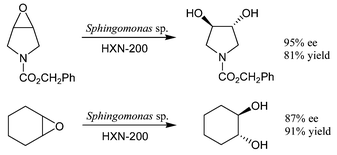Highly enantioselective hydrolysis of alicyclic meso-epoxides with a bacterial epoxide hydrolase from Sphingomonas sp. HXN-200: simple syntheses of alicyclic vicinal trans-diols
Abstract

* Corresponding authors
a
Institute of Biotechnology, Swiss Federal Institute of Technology Zurich, ETH-Hoenggerberg, CH-8093 Zurich, Switzerland
E-mail:
zhi@biotech.biol.ethz.ch
Fax: +41 1 633 1051
Tel: +41 1 633 3811

 Please wait while we load your content...
Something went wrong. Try again?
Please wait while we load your content...
Something went wrong. Try again?
D. Chang, Z. Wang, M. F. Heringa, R. Wirthner, B. Witholt and Z. Li, Chem. Commun., 2003, 960 DOI: 10.1039/B300435J
To request permission to reproduce material from this article, please go to the Copyright Clearance Center request page.
If you are an author contributing to an RSC publication, you do not need to request permission provided correct acknowledgement is given.
If you are the author of this article, you do not need to request permission to reproduce figures and diagrams provided correct acknowledgement is given. If you want to reproduce the whole article in a third-party publication (excluding your thesis/dissertation for which permission is not required) please go to the Copyright Clearance Center request page.
Read more about how to correctly acknowledge RSC content.
 Fetching data from CrossRef.
Fetching data from CrossRef.
This may take some time to load.
Loading related content
